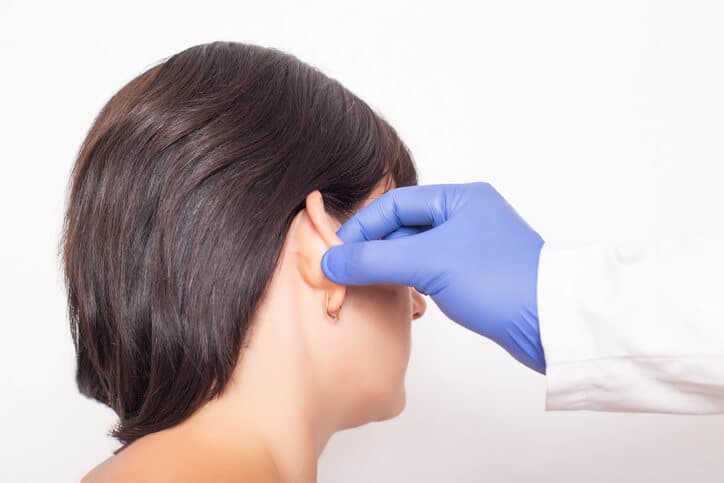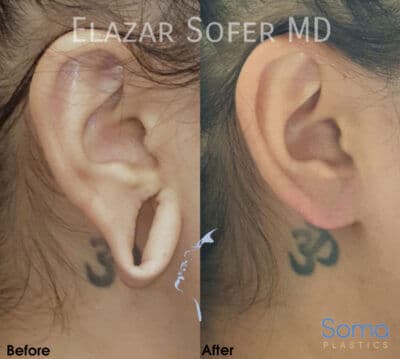Otoplasty, or cosmetic ear surgery, is a procedure with the goal of improving the ear’s functionality and/or improving its appearance. Often this type of reconstructive surgery corrects prominent ears in children, though otoplasty can also repair injuries or congenital disabilities.
If you or your child have ears that stick too far out from your head, are too large compared to your head, or if you are dissatisfied with previous ear surgery, contact Soma Plastics to consult with a doctor today.
How to Prepare for Otoplasty Surgery
Otoplasty surgery won’t change your ears’ location, and it should not alter your ability to hear. However, ears are complex structures, so choose a doctor who has experience performing this procedure.
Your doctor should ask you to take these steps to prepare for otoplasty surgery:
- Do not ingest any products containing aspirin for ten days before your surgery, as aspirin thins the blood and can cause complications. Anti-inflammatory medications such as Advil should not be taken four days before surgery unless you are specifically approved by your doctor.
- A day or two before your appointment, pick up your doctor-approved pain relievers from your pharmacy.
- If you smoke, quit or cut back significantly in the two weeks leading up to your surgery to prevent post-op coughing and bleeding.
- You will not be able to eat for six hours before your procedure, including drinking water and chewing gum. Stock your pantry with easy-to-eat, light meals for your recovery.
- If you experience symptoms of the flu or a cold close to your surgery date, call your doctor’s office so they can decide whether or not it is safe to proceed.
What to Expect From Otoplasty Surgery

When you arrive at the hospital, you will first be taken to a pre-op holding room where a nurse will start an intravenous (IV) infusion line and confirm all your paperwork.
An anesthesiologist will meet you in the operating room and add medication to your IV to make you comfortable and promote sleep. They will also monitor your blood pressure and pulse for the entirety of your surgery.
Expect the surgery to last 2 to 3 hours. Your doctor will make incisions on the back of your ear or at your ear’s inner creases. They will then remove or resituate your cartilage and skin. The number and placement of incisions often affect the otoplasty surgery price.
Post-Otoplasty Surgery

After surgery, you will be taken to a recovery room until your medication wears off. Otoplasty surgery is an outpatient procedure, but someone will need to drive you home and help you with routine tasks 24 hours after surgery. You should also follow these additional guidelines:
- To prevent swelling and bruising, sleep with your head upright on your first day home, and avoid sleeping on your side for a few days. Minor discomfort and itching are common.
- Do not remove any bandages or wash your face for one week after surgery. Dressings protect open wounds from infection, but they also hold your ears in the appropriate position while they heal.
- After your dressings are removed, you will need to wear a loose headband for the 2 to 6 weeks of otoplasty recovery time, particularly at night.
- Avoid hot liquids and slowly introduce different foods until you can resume your regular diet. Often the medications used before Otoplasty surgery and during the recovery for otoplasty can cause nausea and vomiting.
Complications
Any surgical procedure can have complications, including otoplasty. By understanding what to expect, Soma Plastics can prepare you for the worst, so the worst won’t happen. Look out for these signs after your procedure:
- An infection on the skin of the ear or the cartilage inside the ear
- Bleeding or drainage from the ear, or bruising beneath the skin (if you feel pain on only one ear after surgery, this could be a sign of a hematoma)
- Numbness around the ear or face
- An overgrowth of scar tissue
- Prolonged pain or impaired hearing
- Shrinking of the ear canal
- Permanent sutures are becoming visible beneath the skin.
- A fever higher than 101.5 degrees Fahrenheit
When your doctor approves the removal of your bandages, dip a Q-tip in hydrogen peroxide and gently remove the crust from around your wound to promote healing and prevent excess scarring. Use a gentle soap to clean your face and avoid scrubbing. If possible, don’t wear glasses or earrings for the first three weeks.
The outer ear, known as the pinna, has a minor function when it comes to hearing. That is why there are so many otoplasty surgeries performed each year. Protruding ears occur when babies are born with overdeveloped or underdeveloped cartilage, or receive an injury to that cartilage.
If you are distracted, embarrassed, or have experienced harassment because of your ears, call Soma Plastics for a consultation.

